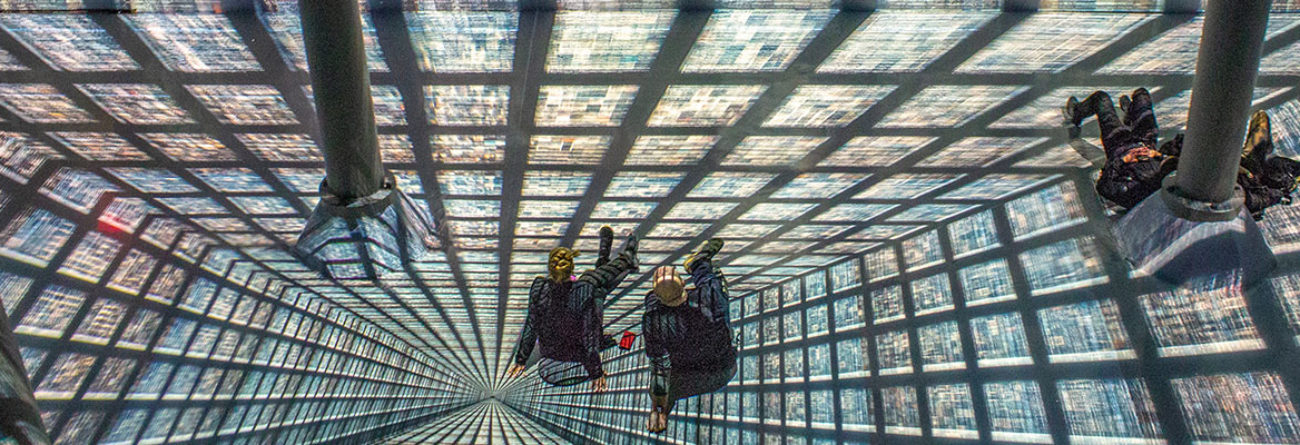
Meet Your Neighbor: Tati Pastukhova of Artechouse
New York City has inspired the work of poets, artists, musicians, businessmen, scientists and countless others. Now, we can include among them a very active computer that is currently showcasing its work in the long-abandoned boiler room of Chelsea Market.
After ingesting 100 million images of the city that never sleeps, that computer – or rather, the algorithms that drive it – interpreted that data and that interpretation (as well as the cognitive process that led it to that interpretation) is now on display in a dizzying, immersive light installation called “Machine Hallucination” by the Turkish artist Refik Anadol. Vaguely familiar forms of notable landmarks – The Brooklyn Bridge, the Flatiron Building– as well as random tenement building and streets can be glimpsed among the millions of pulsating images that jump frenetically back and forth around the room, accompanied by thunderous music.
“While this space has been sitting dormant, it’s been dreaming about all the buildings that were going up around it,” said Tati Pastukhova, a Related resident who co-founded Artechouse, the arts organization that produced “Machine Hallucination,” during a recent tour, “We worked with Refik to create an experience that would tell the story of New York.”
New York is the newest location for Artechouse (an amalgam of Art – Tech – House), which Pashtukhova and her husband, Sandro Kereselidze officially founded in 2015, with the fist location opening in 2017 in Washington D.C. and later in Miami. Less a gallery than a production studio, Artechouse at its core is a space outfitted with the latest technology allowing digital artists to display their work.
“We’re trying to change the way that art is created, we see this as a tool for the 21st century, just like years ago, the camera changed the way that we see and experience theater with the movies.”
Pastukhova and Kereselidze started Artechouse – or some form of it – in 2009 while living in D.C. The origins were much less technical in scope; in the beginning, they simply wanted to create a type of salon where people could come socialize with artists and learn what was happening in the art world. The concept turned out to be immensely popular – over 500 people showed up to their first salon – and over the next nine years, they became the largest platform for contemporary artists in DC, enacting over 200 art exhibitions, concerts and festivals per year, showcasing over 1,000 artists, and partnering with the city and brands like the Ritz Carlton.
It was at this point that they decided they needed a dedicated art space where they could produce work on their own timelines. They had helped to bring the digital arts festivals Nuit Blanche and Fête de Lumières to DC, and were inspired by the work the digital artists they met were doing – and the fact that they didn’t have a dedicated space to exhibit. Because of the difficulty in staging digital art, digital artists have very few places where they can exhibit, and Pastukhova and Kereselidze saw that as an opportunity.
“Over time, that idea formed and we decided to dedicate our art space to the future of art, which we see in technology,” Pastukhova said.
Hence, the space itself is outfitted with the type of tech most artists (or computers) can only dream of, including the largest seamless megapixel count in a cultural institution and L’ISA Immersive Hyperreal Sound technology.
Though Artechouse is the type of visual feast that practically screams for people to capture it and post about it on Instagram, it is not one of the “Instagram experience” exhibition spaces that have cropped up in the past few years (i.e. The Museum of Ice Cream, Candytopia and Rosé House), where taking a picture for Instagram is literally the only point of visiting. Rather, this space has much higher ambitions to be a place for people to experience new forms of art and for artists to test the limit of what it is now possible for them to create. And art, as Pastukhova points out, is more endurable than any one form of social media.
“Today it’s Instagram, 10 years ago it was Facebook, who knows what it’s going to be in 10 years?” she said, “On the other hand, I think when you talk about art, it’s something that lasts regardless of what trends we go through.”
Pastukhova and Kereselidze do seem to harbor a certain appreciation for older pieces; they live a few blocks from Chelsea Market in a Related apartment furnished with art and technology – but not the kind you might think.
“We don’t have any regular music player, we have a vinyl player, an old record player," she said, noting that they collect vinyl records and vintage cameras.
Given how hard it is to display digital art, they don't have any in their apartment, "We do have art, but the art has a different type of meaning," she said, "We have watercolor paintings from my husband’s late mother.”
The Related Life is written and produced by Related Luxury Rentals. Be sure to follow us on Facebook, Twitter and Instagram for the latest events, news and announcements in your area, and tag us for a chance to be featured @therelatedlife and #therelatedlife.

